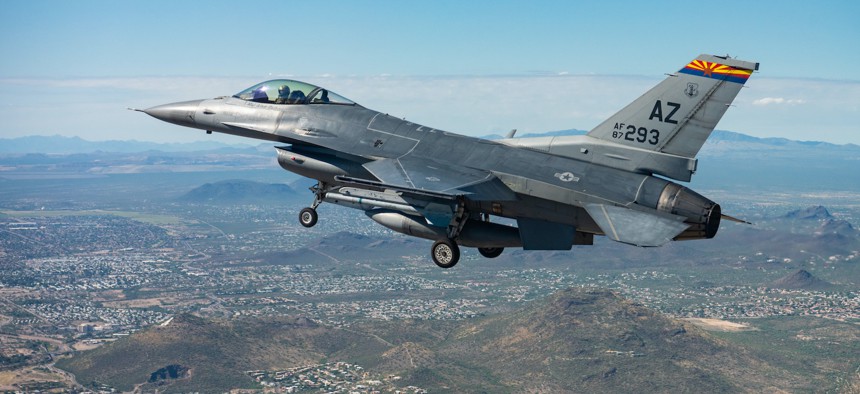
An F-16 assigned to the 162nd Wing, Morris Air National Guard Base, flies over Tucson, Arizona. U.S. Air National Guard / Tech. Sgt. Hampton E. Stramler
Some Ukrainian pilots could finish training in as few as three months
Air National Guard director said shorter timeline is “absolutely realistic” for experienced pilots.
Ukrainian pilots may complete their F-16 training in as little as three months, the Air National Guard estimates.
The Pentagon announced in August that it will begin training Ukrainian pilots on the fighter jets in October at Morris Air National Guard base in Tucson, Arizona.
“Depending on their level of proficiency in fighters and how much they have, [it will take] anywhere from three months to up to as long as nine months at Tucson to get ready,” Lt. Gen. Michael Loh, Air National Guard director, told reporters Tuesday at the Air & Space Forces Association’s annual Air, Space & Cyber conference.
A U.S. Air Force assessment leaked earlier this year said the U.S. could train Ukrainian pilots as quickly as four months.
However, the two Ukrainian pilots in the assessment already had proficient English and flying skills, Loh said, noting that his three- to nine-month estimate does not include English training.
“Nine months is what we do, day in and day out. It doesn't matter what country you're from, or where you are from. It takes about nine months from the time that you walk into Tucson until you graduate that course. And that's standard,” he said.
The Pentagon previously said that starting in September, F-16 pilots will receive English language training at Lackland Air Force Base in San Antonio, Texas, and then start flight training in Tucson.
But for the Ukrainian soldiers who are experienced with flying day-to-day sorties defending their homeland, Loh said, “I think three months is absolutely realistic.”
The training will occur in three phases, Loh said: ground training, simulator training, and flight training.
While Loh said Ukrainian pilots will be flying F-16s in Tucson before the end of the year, “flying and employing are two different things.”
And it’s not as simple as finishing the training and heading back to Ukraine to start fighting in three months, he said.
“I would probably say you have to also get the maintenance, weapons support, fuel—all the other logistics pieces in place. And so that's going to come together over in NATO. And so once they're trained here to go fly, they'll go back there to NATO and fly before they actually go into Ukraine to go do that,” Loh said.
Loh said he can’t detail how many pilots coming to the U.S. have flying experience, but “the ones that they're bringing over right now are ones that they think will be their future in the future of the Air Force.”
Training these pilots will force the Arizona Guard to “displace some others that were in line to do a foreign military sales training or U.S. training, because we do both there, and then prioritize Ukrainian pilots,” Loh said.




